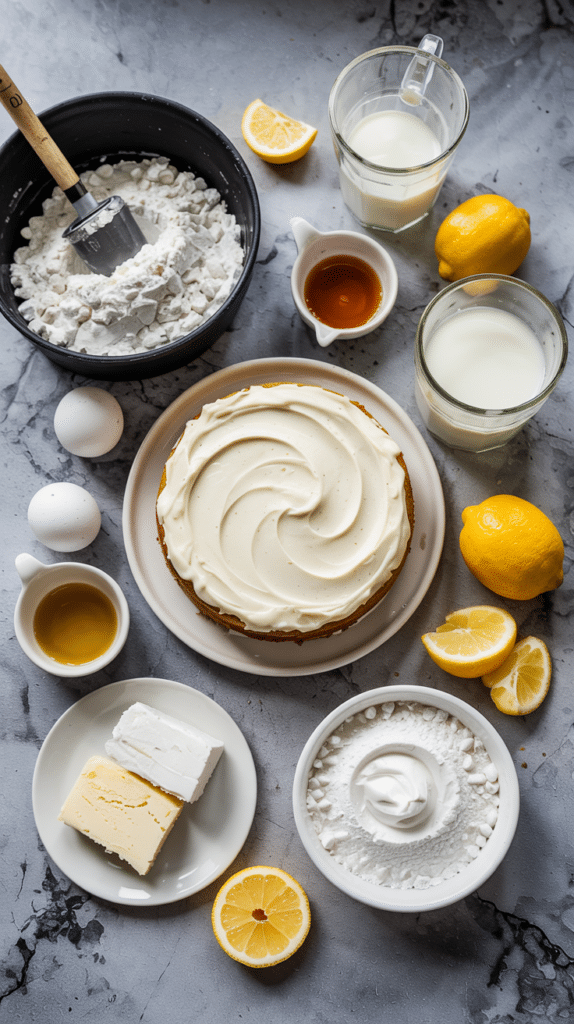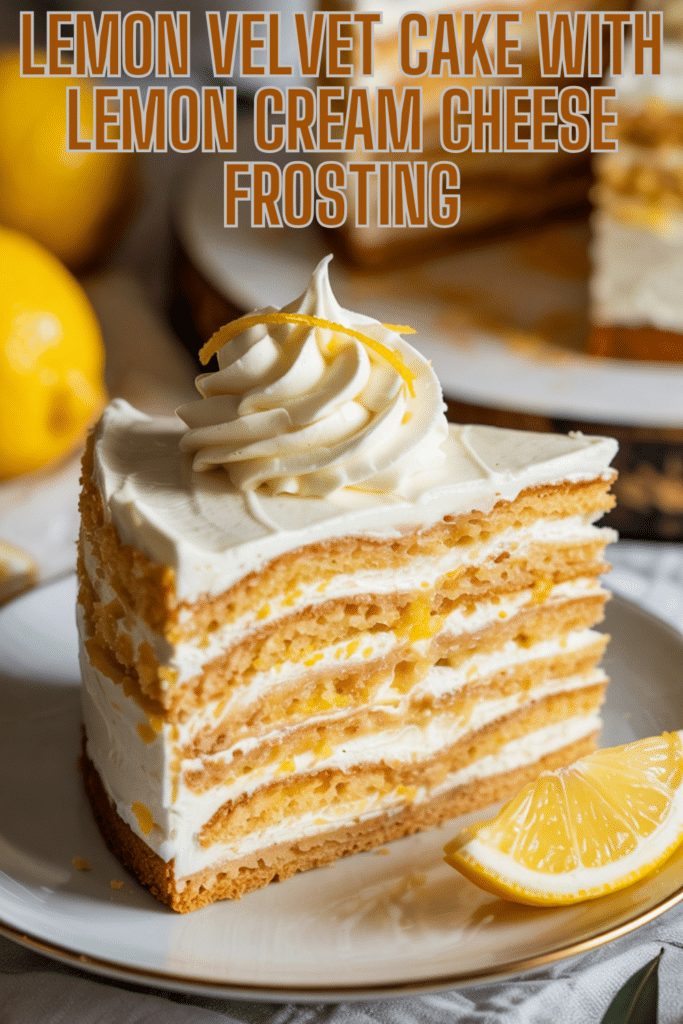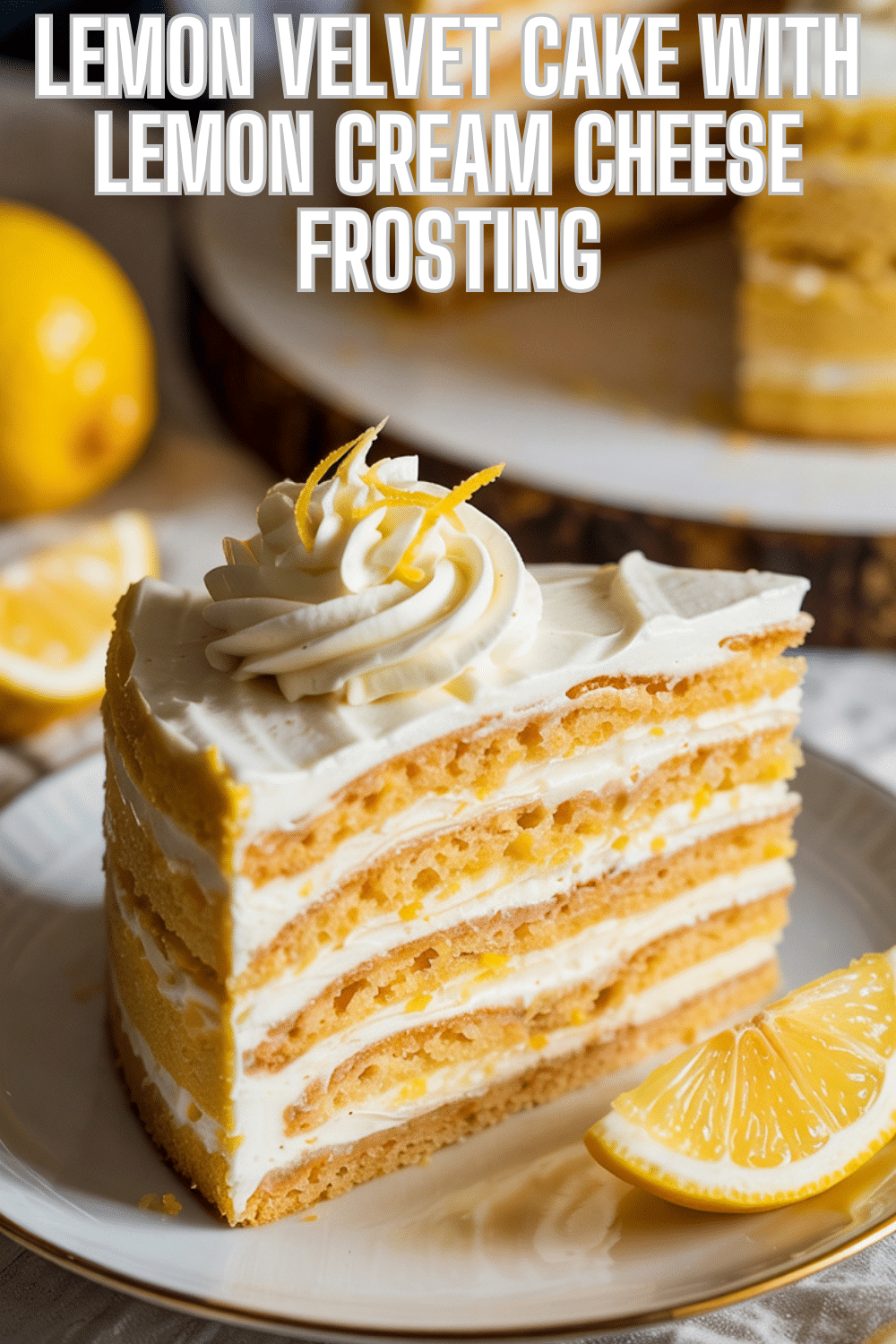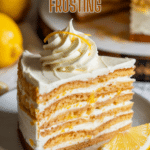Introduction & Inspiration
Move over, red velvet – there’s a new velvet cake in town! This Lemon Velvet Cake captures that signature tender, almost velvety crumb but infuses it with bright, zesty lemon flavor. Made moist with oil, shortening, and buttermilk, and enhanced with multiple layers of lemon, this cake is a true delight. Paired with its perfect match, a tangy lemon cream cheese frosting, it’s sunshine in every slice.
My inspiration for this recipe comes from wanting to translate the beloved texture of a velvet cake to a different flavor profile. Lemon felt like the perfect bright, cheerful counterpart, creating a cake that’s both comforting in texture and refreshing in taste. I wanted a truly moist, flavorful lemon layer cake.
This cake is wonderful for spring celebrations, Easter (just passed!), Mother’s Day (coming up!), birthdays, or anytime you want a dessert that’s both elegant and deeply satisfying. It’s a sophisticated twist on familiar favorites. It is a perfect dessert for any occasion.
Nostalgic Appeal
“Velvet” cakes, particularly red velvet, have a distinct nostalgic charm, known for their unique texture and often associated with Southern baking and special occasions. Lemon cake brings its own cheerful nostalgia of sunny days and bright flavors. Cream cheese frosting is, of course, a universally loved classic comfort.
This Lemon Velvet Cake blends these appealing elements. It offers the textural surprise and special feel of a velvet cake, combined with the bright, happy flavors of lemon and the comforting tang of cream cheese frosting. It feels both new and reassuringly familiar.
It’s a cake that bridges sophistication and comfort, perfect for creating sweet memories. A perfect dessert, to share with family and friends.
Homemade Focus
This Lemon Velvet Cake recipe is a celebration of homemade baking techniques that create a unique texture and flavor profile. We’re carefully combining different fats (oil and shortening), acids (buttermilk, vinegar, lemon juice), and leaveners (baking soda, baking powder) along with a mix of flours to achieve that signature “velvet” crumb.
The frosting is also made from scratch, whipping softened butter and cream cheese with lemon and sugar for that perfect tangy-sweet balance. Making both components allows full control over the lemon intensity and the final texture.
It’s about understanding how ingredients interact to create something special – a cake that’s more than the sum of its parts. The homemade effort results in a uniquely moist, tender, and flavorful dessert. The homemade flavour is delicious.
The primary flavor goal is a bright, vibrant, multi-layered lemon flavor balanced by a subtle tang and appropriate sweetness, all delivered in an exceptionally moist and tender crumb. The lemon comes from zest, extract, and juice, ensuring a well-rounded citrus profile.
Flavor Goal
The cake should have that characteristic “velvet” texture – soft, fine-crumbed, and very moist. The cream cheese frosting should be tangy, creamy, smooth, and fluffy, with its own distinct lemon notes complementing the cake without being overwhelming.
The overall experience should be a burst of lemon sunshine, balanced by creamy tanginess, with an incredibly pleasing, melt-in-your-mouth texture. It’s designed to be the ultimate moist lemon cake experience. A perfect balance between texture and flavour.
Ingredient Insights
For the Cake:
- All-Purpose Flour & Cake Flour: Using a blend provides structure from the AP flour while the cake flour ensures extra tenderness.
- Baking Soda & Baking Powder: Leavening agents. Baking soda reacts with acidic buttermilk, vinegar, and lemon juice.
- Salt: Balances sweetness and enhances flavors.
- Granulated Sugar: Sweetens the cake.
- Vegetable Oil & Butter-Flavored Shortening: A combination for ultimate moisture (from oil) and some buttery flavor/structure (from shortening). Using all oil or all butter would also work but change the texture slightly.
- Large Eggs (Room Temperature): Provide structure, richness, binding.
- Vanilla Extract & Lemon Extract: Vanilla provides warmth, while lemon extract boosts the citrus flavor intensely.
- Lemon Zest: Adds bright, aromatic lemon oils directly into the batter.
- Buttermilk (Room Temperature): Adds moisture, tang, and activates baking soda for tenderness.
- White Vinegar: Adds extra acidity for reaction with baking soda, enhancing tenderness.
- Hot Lemon Water: Hot liquid helps bloom cocoa in chocolate cakes; here, hot lemon-infused water likely helps create a smooth batter and activate leaveners quickly for a tender crumb.
- Yellow Food Coloring (Optional): Enhances the visual “lemon” color, purely aesthetic.
For the Lemon Cream Cheese Frosting:
- Cream Cheese (Softened): The tangy, creamy base. Use full-fat, brick-style, properly softened.
- Unsalted Butter (Softened): Adds richness, structure, and smoothness. Properly softened.
- Vanilla Extract & Lemon Extract: Flavor the frosting.
- Lemon Zest: Adds fresh, bright lemon notes.
- Powdered Sugar (Sifted): Sweetens and thickens the frosting. Sifting is crucial for smoothness. Amount adjustable.
- Lemon Juice (If Needed): To adjust consistency or add extra tartness.
- Yellow Food Coloring (Optional): To tint the frosting yellow.
Essential Equipment
- Two 9-Inch Round Cake Pans: For baking the layers.
- Parchment Paper (Recommended): For lining pan bottoms.
- Baking Spray (with flour preferably) or Grease & Flour: For preparing pans.
- Electric Mixer (Stand Mixer or Handheld): Essential for properly creaming fats/sugar and whipping the frosting.
- Mixing Bowls (Large, Medium): For dry ingredients, wet ingredients, frosting.
- Whisk: For combining dry ingredients.
- Rubber Spatula: For scraping bowls and ensuring even mixing.
- Wire Cooling Racks: Crucial for cooling cake layers completely.
- Offset Spatula: For frosting the cake smoothly.
- Serving Plate or Cake Stand:
Ingredients
For the Cake: (Ensure wet ingredients like eggs, buttermilk are at room temperature)
- 1 1/2 cups all-purpose flour
- 1 cup cake flour
- 1 tsp baking soda
- 1 tsp baking powder
- 1 tsp salt
- 1 3/4 cups granulated sugar
- 3/4 cup vegetable oil
- 1/4 cup butter-flavored shortening (or regular shortening)
- 2 large eggs, room temperature
- 1-2 tsp vanilla extract (use 2 tsp for more flavor)
- 1 tbsp lemon extract
- 1 heaping tsp lemon zest
- 1 cup buttermilk, room temperature
- 1/2 tsp white distilled vinegar
- 1/3 cup hot lemon water (mix 2 tbsp fresh lemon juice with 1/3 cup hot water)
- 4-6 drops yellow food coloring (optional)
For the Lemon Cream Cheese Frosting:
- 16 oz (2 blocks) cream cheese, softened
- 8 tbsp (1 stick) unsalted butter, softened
- 1 1/2 tsp vanilla extract
- 1 1/2 tsp lemon extract
- 1 1/2 heaping tsp lemon zest
- 4-5 cups powdered sugar, sifted (adjust to taste/consistency)
- 1-2 tsp lemon juice (if needed for consistency)
- 4-5 drops yellow food coloring (optional)

Step-by-Step Instructions
1. Prepare Oven and Pans:
- Preheat oven to 325°F (160°C).
- Grease and flour two 9-inch round cake pans. Lining the bottoms with parchment paper is also recommended.
2. Combine Dry Cake Ingredients:
- In a medium bowl, whisk together the all-purpose flour, cake flour, baking soda, baking powder, and salt. Set aside.
3. Combine Wet Cake Ingredients:
- In a large bowl using an electric mixer (stand or handheld), beat the granulated sugar, vegetable oil, and shortening together until combined (it might not get super fluffy like butter/sugar).
- Add the room temperature eggs one at a time, beating well after each.
- Beat in the vanilla extract, lemon extract, and lemon zest until combined.
4. Alternate Dry Ingredients and Buttermilk:
- With the mixer on low speed, alternate adding the dry ingredient mixture and the room temperature buttermilk to the wet ingredients, beginning and ending with the dry ingredients (add flour mix in 3 parts, buttermilk in 2 parts). Mix only until just combined after each addition. Do not overmix.
5. Add Final Liquids:
- In a small cup, mix the white vinegar and the hot lemon water together.
- With the mixer still on low (or stir by hand), gently stir this hot liquid mixture into the batter along with the optional yellow food coloring, mixing only until combined.
6. Bake the Cakes:
- Divide the batter evenly between the two prepared pans. Smooth the tops.
- Bake for 25-30 minutes, or until the centers are just set and a toothpick inserted comes out clean or with a few moist crumbs. (Note: Recipe suggests checking early and removing when centers are just set but slightly jiggly – be careful not to underbake, but avoid overbaking).
- Let the cakes cool in the pans on wire racks for 10 minutes.
- Carefully invert the cakes onto the wire racks, remove parchment if used, and let cool completely.
7. Make the Lemon Cream Cheese Frosting:
- Ensure cream cheese and butter are properly softened.
- In a large bowl using an electric mixer, beat the softened cream cheese and softened butter together on medium-high speed until light and fluffy.
- Beat in the vanilla extract, lemon extract, and lemon zest.
- Reduce speed to low. Gradually add 4 cups of the sifted powdered sugar, mixing until smooth.
- Check consistency and sweetness. Add more powdered sugar (up to 1 more cup) if needed for thickness, or 1-2 teaspoons of lemon juice if needed to thin slightly or add more tartness. Add optional yellow food coloring now if using.
- Beat on medium-high speed for another minute or two until very light and fluffy.
8. Assemble and Frost the Cake:
- Ensure cake layers are completely cool. If desired, level the tops with a serrated knife.
- Place the first cake layer on your serving platter or cake stand.
- Spread a generous layer of the lemon cream cheese frosting over the top.
- Place the second cake layer on top.
- Frost the top and sides of the cake with the remaining frosting using an offset spatula. Create decorative swirls if desired.
- Garnish with thin lemon slices if desired.
9. Chill (Recommended):
- Refrigerate the frosted cake for at least 30-60 minutes to allow the frosting to set before slicing and serving.
10. Serve:
- Serving Note: As mentioned in the original notes for a similar frosting, this frosting softens nicely. Let the cake sit out for 10-20 minutes before serving for the best texture if it has been refrigerated for a long time.
- Store leftover cake covered in the refrigerator.

Troubleshooting
- Cake Dry/Dense: Overbaking is a key culprit. Check early! Overmixing after adding flour. Ingredients too cold. Using all AP flour instead of the cake flour blend.
- “Velvet” Texture Missing: Might be overmixed, or leaveners not fresh. The combination of fats, acids, and leaveners aims for this texture.
- Frosting Too Soft: Cream cheese or butter too warm. Not enough powdered sugar. Chill the frosting bowl and re-whip. Add more sifted powdered sugar.
- Frosting Too Stiff: Too much powdered sugar. Beat in lemon juice or milk, 1 teaspoon at a time.
- Frosting Lumpy: Cream cheese or butter not fully softened, or powdered sugar not sifted.
Tips and Variations
- Room Temperature Ingredients: Crucial for cake batter (eggs, buttermilk) and frosting (cream cheese, butter) for smooth results.
- Don’t Overmix Batter: Mix only until combined to keep the cake tender.
- Fresh Lemon: Using fresh zest and juice provides the brightest, best lemon flavor.
- Checking Doneness: Rely on the toothpick test (clean or few moist crumbs) but also the visual cue of the center being “just set.” Avoid overbaking.
- Frosting Adjustments: Adjust powdered sugar for sweetness/thickness and lemon juice/extract for tartness according to your preference.
- All Butter/Oil: You could experiment with using all butter or all oil instead of the oil/shortening blend, but expect texture differences.
Serving and Pairing Suggestions
- Serve Cool Room Temperature: Allows frosting and cake texture to be optimal.
- Spring/Summer Celebrations: Perfect for Easter, Mother’s Day, showers, birthdays.
- With Fresh Berries: Garnish with blueberries or raspberries for color and flavor contrast.
- With Tea: A lovely pairing for an afternoon treat.
Nutritional Information
(Note: Estimated, per slice, assuming 12 slices)
- Calories: 500-650+
- Fat: 30-40g+
- Saturated Fat: 10-18g+
- Cholesterol: 80-110mg+
- Sodium: 250-350mg+
- Total Carbohydrates: 60-75g+
- Dietary Fiber: <1g
- Sugars: 45-60g+
- Protein: 4-6g+
Sunshine Lemon Velvet Cake with Lemon Cream Cheese Frosting
Bake a bright and beautiful Lemon Velvet Cake! This recipe features an incredibly moist, tender crumb with vibrant lemon flavor, topped with a classic tangy lemon cream cheese frosting.
Ingredients
For the Cake: (Ensure wet ingredients like eggs, buttermilk are at room temperature)
- 1 1/2 cups all-purpose flour
- 1 cup cake flour
- 1 tsp baking soda
- 1 tsp baking powder
- 1 tsp salt
- 1 3/4 cups granulated sugar
- 3/4 cup vegetable oil
- 1/4 cup butter-flavored shortening (or regular shortening)
- 2 large eggs, room temperature
- 1–2 tsp vanilla extract (use 2 tsp for more flavor)
- 1 tbsp lemon extract
- 1 heaping tsp lemon zest
- 1 cup buttermilk, room temperature
- 1/2 tsp white distilled vinegar
- 1/3 cup hot lemon water (mix 2 tbsp fresh lemon juice with 1/3 cup hot water)
- 4–6 drops yellow food coloring (optional)
For the Lemon Cream Cheese Frosting:
- 16 oz (2 blocks) cream cheese, softened
- 8 tbsp (1 stick) unsalted butter, softened
- 1 1/2 tsp vanilla extract
- 1 1/2 tsp lemon extract
- 1 1/2 heaping tsp lemon zest
- 4–5 cups powdered sugar, sifted (adjust to taste/consistency)
- 1–2 tsp lemon juice (if needed for consistency)
- 4–5 drops yellow food coloring (optional)
Instructions
1. Prepare Oven and Pans:
- Preheat oven to 325°F (160°C).
- Grease and flour two 9-inch round cake pans. Lining the bottoms with parchment paper is also recommended.
2. Combine Dry Cake Ingredients:
- In a medium bowl, whisk together the all-purpose flour, cake flour, baking soda, baking powder, and salt. Set aside.
3. Combine Wet Cake Ingredients:
- In a large bowl using an electric mixer (stand or handheld), beat the granulated sugar, vegetable oil, and shortening together until combined (it might not get super fluffy like butter/sugar).
- Add the room temperature eggs one at a time, beating well after each.
- Beat in the vanilla extract, lemon extract, and lemon zest until combined.
4. Alternate Dry Ingredients and Buttermilk:
- With the mixer on low speed, alternate adding the dry ingredient mixture and the room temperature buttermilk to the wet ingredients, beginning and ending with the dry ingredients (add flour mix in 3 parts, buttermilk in 2 parts). Mix only until just combined after each addition. Do not overmix.
5. Add Final Liquids:
- In a small cup, mix the white vinegar and the hot lemon water together.
- With the mixer still on low (or stir by hand), gently stir this hot liquid mixture into the batter along with the optional yellow food coloring, mixing only until combined.
6. Bake the Cakes:
- Divide the batter evenly between the two prepared pans. Smooth the tops.
- Bake for 25-30 minutes, or until the centers are just set and a toothpick inserted comes out clean or with a few moist crumbs. (Note: Recipe suggests checking early and removing when centers are just set but slightly jiggly – be careful not to underbake, but avoid overbaking).
- Let the cakes cool in the pans on wire racks for 10 minutes.
- Carefully invert the cakes onto the wire racks, remove parchment if used, and let cool completely.
7. Make the Lemon Cream Cheese Frosting:
- Ensure cream cheese and butter are properly softened.
- In a large bowl using an electric mixer, beat the softened cream cheese and softened butter together on medium-high speed until light and fluffy.
- Beat in the vanilla extract, lemon extract, and lemon zest.
- Reduce speed to low. Gradually add 4 cups of the sifted powdered sugar, mixing until smooth.
- Check consistency and sweetness. Add more powdered sugar (up to 1 more cup) if needed for thickness, or 1-2 teaspoons of lemon juice if needed to thin slightly or add more tartness. Add optional yellow food coloring now if using.
- Beat on medium-high speed for another minute or two until very light and fluffy.
8. Assemble and Frost the Cake:
- Ensure cake layers are completely cool. If desired, level the tops with a serrated knife.
- Place the first cake layer on your serving platter or cake stand.
- Spread a generous layer of the lemon cream cheese frosting over the top.
- Place the second cake layer on top.
- Frost the top and sides of the cake with the remaining frosting using an offset spatula. Create decorative swirls if desired.
- Garnish with thin lemon slices if desired.
9. Chill (Recommended):
- Refrigerate the frosted cake for at least 30-60 minutes to allow the frosting to set before slicing and serving.
10. Serve:
- Serving Note: As mentioned in the original notes for a similar frosting, this frosting softens nicely. Let the cake sit out for 10-20 minutes before serving for the best texture if it has been refrigerated for a long time.
- Store leftover cake covered in the refrigerator.
Recipe Summary and Q&A
Summary: This Lemon Velvet Cake features a tender, moist crumb achieved through a blend of flours, oil, shortening, buttermilk, and vinegar, infused with bright lemon flavor. It’s frosted with a classic tangy lemon cream cheese frosting. The process involves mixing the unique cake batter, baking the layers, cooling completely, preparing the frosting, and assembling/frosting the cake.
Q&A:
- Q: What makes this a “Velvet” cake if it’s not Red Velvet?
- A: The “Velvet” description usually refers to the very soft, fine, moist, almost velvety crumb texture, often achieved through the chemical reaction between acidic ingredients (like buttermilk, vinegar, lemon juice) and baking soda, along with fats like oil. Red velvet just adds cocoa and red color to this base concept.
- Q: Can I use all all-purpose flour?
- A: You can, but using part cake flour as specified will yield a more tender, finer crumb characteristic of a velvet cake. If using all AP, consider the substitution method mentioned in previous recipes (replacing some flour with cornstarch).
- Q: Is the food coloring necessary?
- A: No, the yellow food coloring is purely optional for enhancing the visual “lemon” color. The cake will taste the same without it.
- Q: How important is the hot lemon water?

